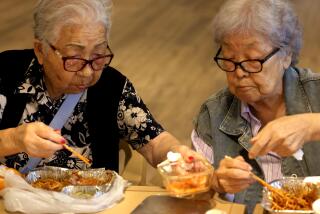LITTLE TOKYO : Extra! Extra! Rafu Shimpo Is 90
- Share via
At a time when newspapers across the country are cutting back and even shutting down, one Los Angeles daily remains steady as it marks its 90th anniversary.
The Rafu Shimpo, the nation’s oldest and largest Japanese-American daily, has weathered bad economic times, anti-Japanese sentiment and a brief shutdown during World War II. But the bilingual Los Angeles newspaper remains a stalwart in the Japanese-American community, bringing relevant international, national and local news to new immigrants and longtime residents alike.
The newspaper will be honored at the Little Tokyo Service Center’s 14th annual community service award dinner Friday at the Westin Bonaventure Hotel.
As early as the 1920s, observers predicted that the Rafu Shimpo, which means “the Los Angeles newspaper,” had a bleak future. Even during its boom years in the 1960s, then-publisher H. T. Komai forecast: “It will become a time of the Nisei (second-generation Japanese-Americans), so there may be no need for a Japanese newspaper. But there should be at least 10 more good years.”
Today, the Rafu Shimpo has 22,000 subscribers, most of whom live in Los Angeles County. The paper, published at 259 S. Los Angeles St. and circulated by mail, reaches readers in the United States, Canada, Mexico and Japan.
Divided into Japanese and English sections, the paper averages 16 pages and covers everything from political upheavals in Japan to American hate crimes to the birth of local newborns. Among the four-page English section’s most-read offerings are the obituaries and local sports league scores.
The Japanese-language section, with its pages of overseas news, probably draws the most readers. Publisher Michael Komai said Japanese readers account for 70% to 80% of the paper’s total readership.
The paper began in 1903 as a one-page, mimeographed Japanese-language newspaper produced by Rippo Iijima, Masaharu Yamaguchi and Seijiro Shibuya. H. T. Komai, who came to the paper as a manager, took over as publisher in 1922, beginning a family dynasty. He was succeeded by son Akira and grandson Michael.
H. T. Komai began the English-language section in 1926 in response to the growing numbers of Nisei.
When Pearl Harbor was bombed on Dec. 7, 1941, H. T. Komai was among the Japanese-American community leaders arrested and interned by the FBI. Akira Komai kept the paper running until April, 1942, when it closed as Japanese-Americans were being sent off to relocation camps across the West.
The paper was revived after the war, thanks to Akira Komai’s foresight and the loyalty of his employees. Komai had arranged for the plant’s rent to be paid during the war and hid the Japanese type under the floorboards. When he was refused loans at local banks, three employees loaned him $1,500. The first postwar issue was published on Jan. 1, 1946.
For the past three years, difficult economic times have caused the Rafu Shimpo to freeze the salaries of its 65 employees and limit expenses in other areas.
“We’ve managed to stay in the black, but not to the point where we could reward our employees like we’d like to,” Komai said.
More to Read
Sign up for Essential California
The most important California stories and recommendations in your inbox every morning.
You may occasionally receive promotional content from the Los Angeles Times.













